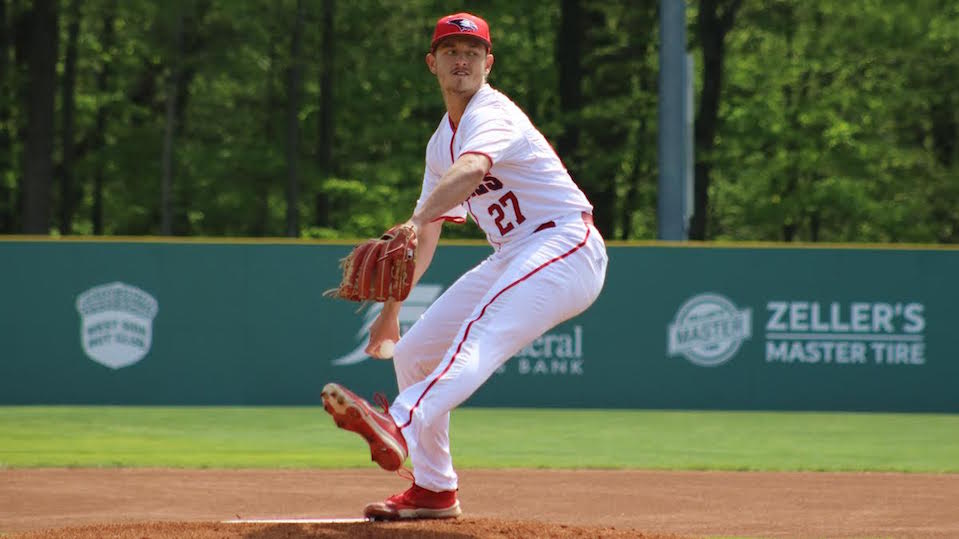
BY STEVE KRAH
Versatility, camaraderie and max effort is part of the value Gavin Seebold brings to the University of Southern Indiana baseball team.
The right-handed pitcher has started and come out of the bullpen for the Evansville-based Screaming Eagles.
The 21-year-old is always there to back his teammates.
Jeffersonville (Ind.) High School graduate Seebold knows that grit has its rewards.
“Any role, I’m prepared to do it,” says Seebold. “At the beginning of the year we were looking at me as more of a closer. The coaches asked me to start a game, I did pretty well in it and they asked me to start again. The just left me in that role.
“At tournament time, I may come out of the pen.”
Seebold lists some of his best athletic qualities.
“It’s probably my determination,” says Seebold. “I feel like I support all the guys on my team. I’m hard-working. You have to work hard to be in a successful position.”
In a dozen 2024 mound appearances (six starts), Seebold is 6-2 with a 4.13 earned run average, 41 strikeouts and 11 walks in 48 innings. He is scheduled to take the ball again Saturday as part of a three-game Ohio Valley Conference series May 3-5 for USI (19-26, 8-10) vs. Southern Illinois University-Edwardsville.
Seebold has made improvements since the 2023 season when he was in 13 games (eight starts) and went 2-4 with an 8.27 ERA, 26 strikeouts and 23 walks in 37 innings.
“I attribute that to confidence — confidence that teammates have in me, coaches have in me and that I have in myself,” says Seebold. “Also, last year I didn’t have a feel for a breaking pitch.”
The 6-foot-1, 200-pound hurler now combines a slider with a four-seam fastball and change-up.
“(The ) opens up my fastball, who has been my go-to pitch all my life,” says Seebold. “I spot my fastball pretty well.”
Throwing from a three-quarter arm slot, Seebold has topped out at 93 mph while setting at 88 to 91 with his four-seamer.
“I get a little arm-side run,” says Seebold. “Some days more than others.”
He sometimes refers to the slider as a “slurve.”
“Some days it looks more like a curveball, some days it looks like a slider,” says Seebold.
He began to work on the pitch at the end of last spring, during the summer with the Ohio Valley League’s Louisville Jockeys and in the fall at USI.
“I like my change-up a lot,” says Seebold. “It’s pretty traditional with my middle and ring finger over the two seams.
“I have a tremendous amount of confidence in it.”
He is able to throw it over both sides of the plate, making it pair well with his fastball. He’s had chases and occasionally throws it back-door to right-handed batters.
Both the slider and curve are thrown as hard as he can — the slider at 77 to 81 mph and the change at 83 to 87 (that’s up from 77 to 81 in 2023).
During catch play, Seebold focuses on releasing the ball over-the-top which helps with his mechanics once he steps on the mound.
Seebold was born in the Jeffersonville area and played a Jeff/GRC Little League from machine pitch to 12-year-old all-stars. Travel teams included the Ironmen, Indiana Showcasers and Canes Midwest 17U among a few others.
At Jeffersonville High School, Seebold was an honorable mention all-Hoosier Hills Conference performer. In his best season, he went 9-2 with a 2.46 ERA and 60 strikeouts in 57 innings for the Derek Ellis-coached Red Devils.
“Derek helped me gain confidence in myself,” says Seebold of Ellis. “He also helped my team and I building a winning culture of brotherhood and playing for one another.
“I’m thankful for the time the coaches spent with us and for all the time I spent in Jeffersonville baseball.”
The 2020 graduate saw his senior season taken by the COVID-19 pandemic.
From Jeff, Seebold went to Eastern Kentucky University.
Battling elbow pain and taking PRP injections, Seebold did not pitch for the Colonels and was a medical redshirt in 2021 and red-shirted again after transferring to Southern Indiana and missed the 2022 season. His Tommy John surgery was in May 2021 and he was able to pitch again in July 2022. That’s when he played for the Bag Bandits of the College summer League at Grand Park in Westfield, Ind.
At USI, Seebold plays for head coach Tracy Archuleta.
“It’s a great opportunity,” says Seebold of playing for a man in his 18th season leading the program with 711 total wins as a college head coach. “He’s been around the game for a long time. He’s got a lot of knowledge.
“He wants us to succeed.”
Nick Gobert is the Screaming Eagles pitching coach and has aided Seebold with tweaks and fixes to his delivery.
“He tells me a lot to just trust my stuff,” says Seebold of Gobert. “A lot of times I swing open with my front side. He tells me stay closed as long as possible and get down the mound. A lot of times I can I get stuck in my back leg. He gives me some pointers on getting everything flowing.
“I’m thankful that we have him.”
The USI staff also features assistants Vinny Tornincasa and Gordon Cardenas and director of operations Aaron Furman.
Seebold is scheduled to graduate this month with an Individual Studies degree and has two more years of eligibility. He says he will likely begin work in 2024-25 on a Masters of Business Administration with a concentration on Data Analytics.
This summer, he intends to train at Tread Athletics in Pineville, N.C.
Gavin is the oldest of John and Corinne Seebold’s two sons. Grant Seebold (Our Lady of Providence High School Class of 2023) is now a 6-foot-5 freshman right-handed pitcher at Oakland City (Ind.) University. Their mother played volleyball at Tennessee Tech. Their father grew up a Cincinnati Reds fan and that’s Gavin’s favorite team.
A recreational basketball player growing up, Gavin also follows the fortunes of the men’s hoops team at the University of Kentucky.







